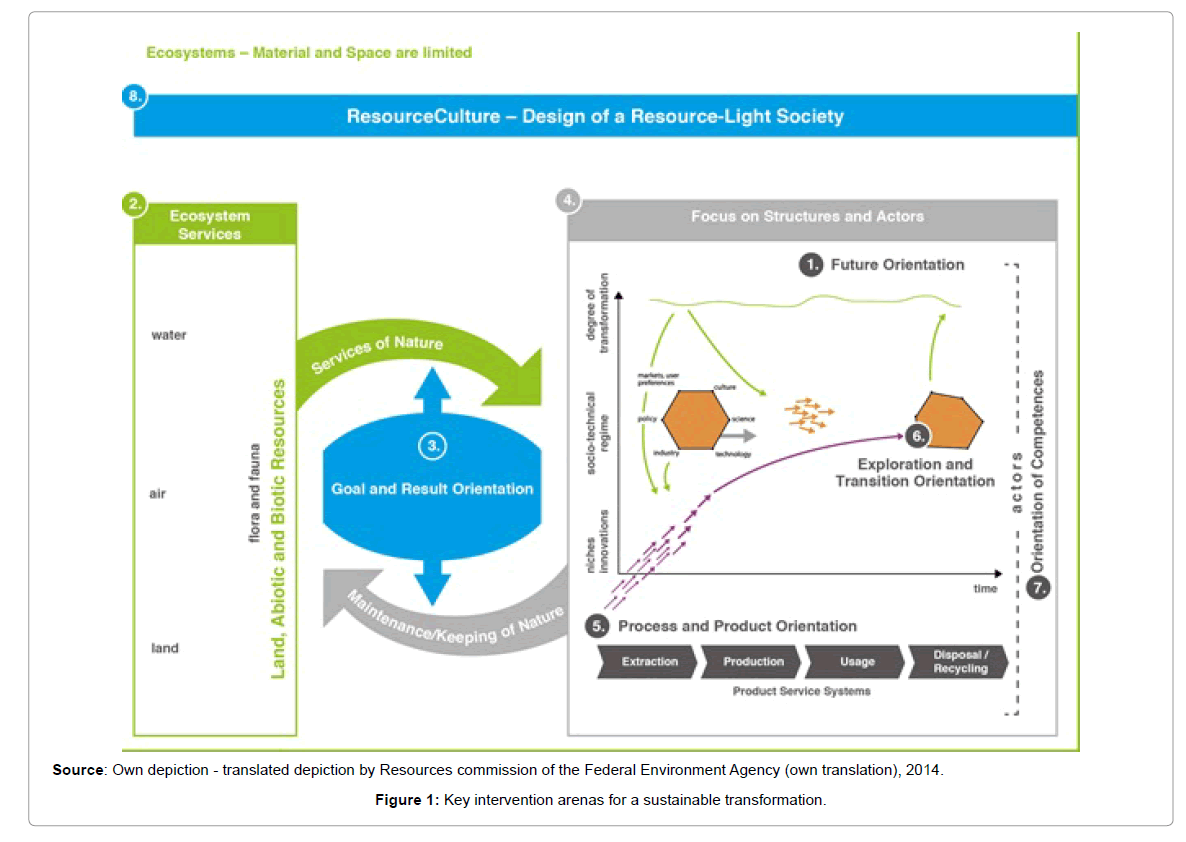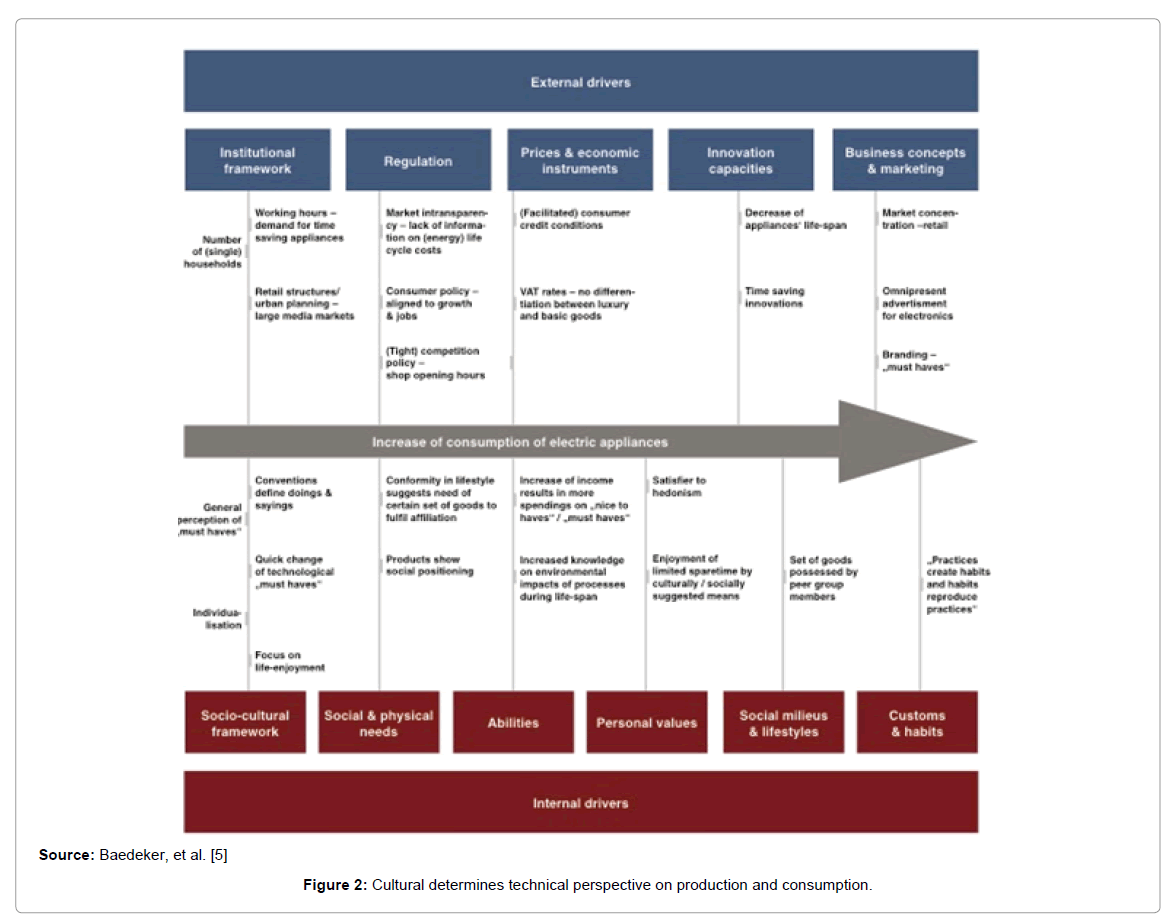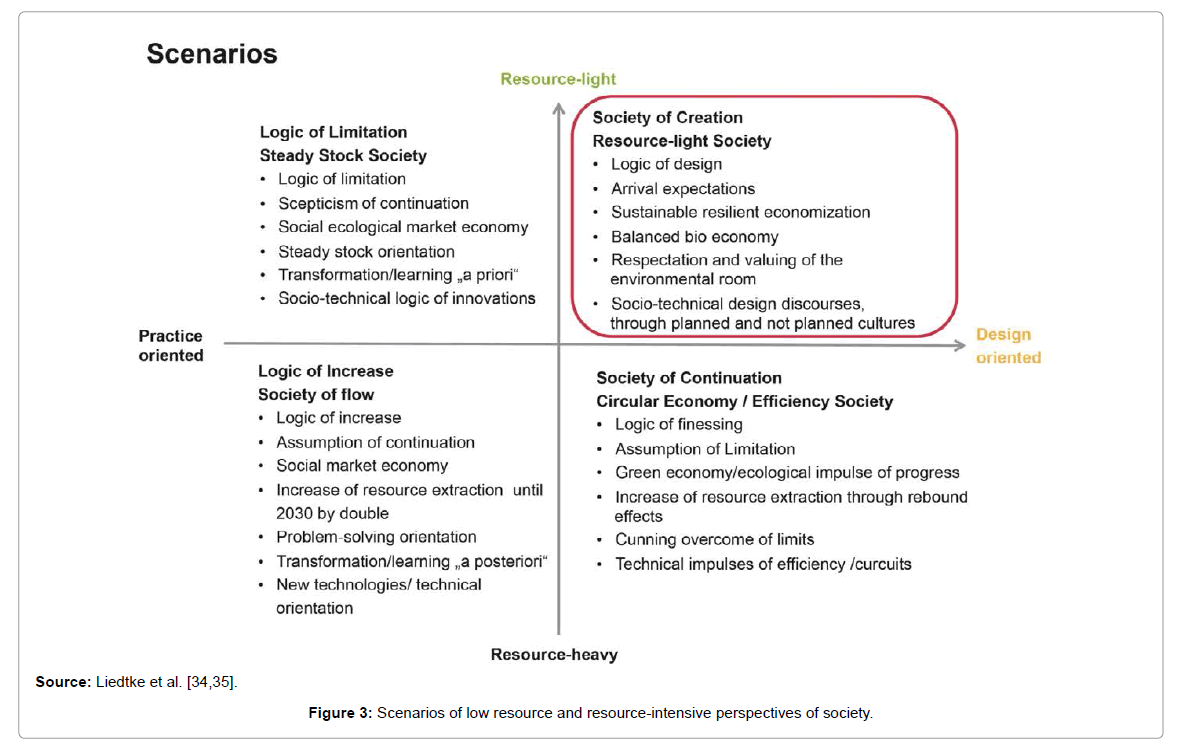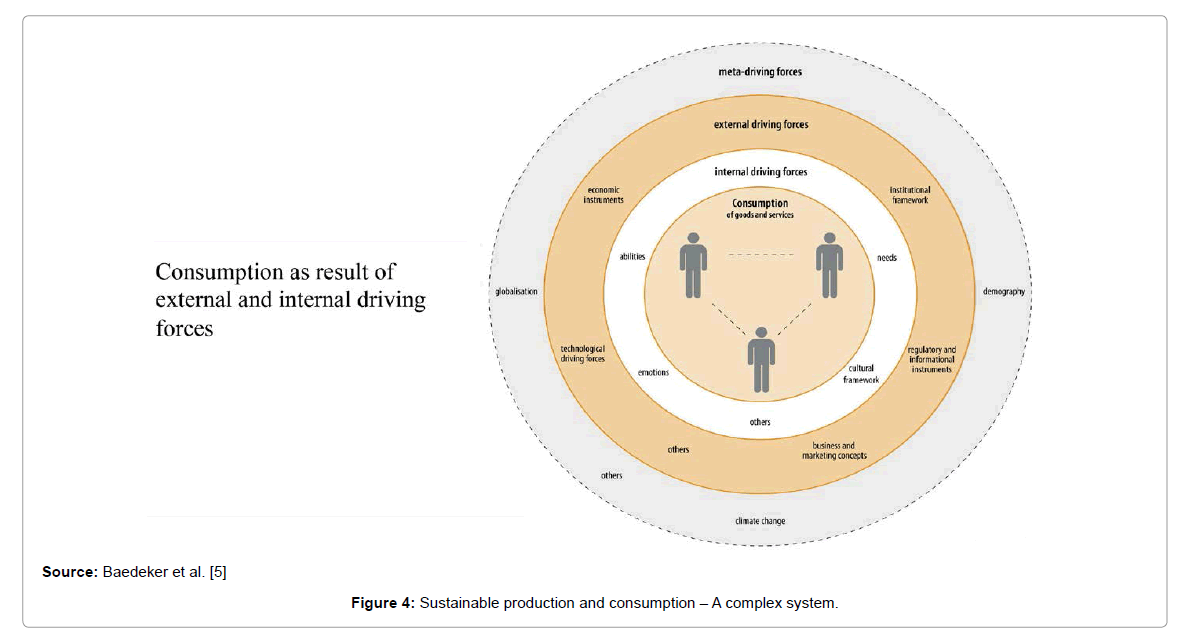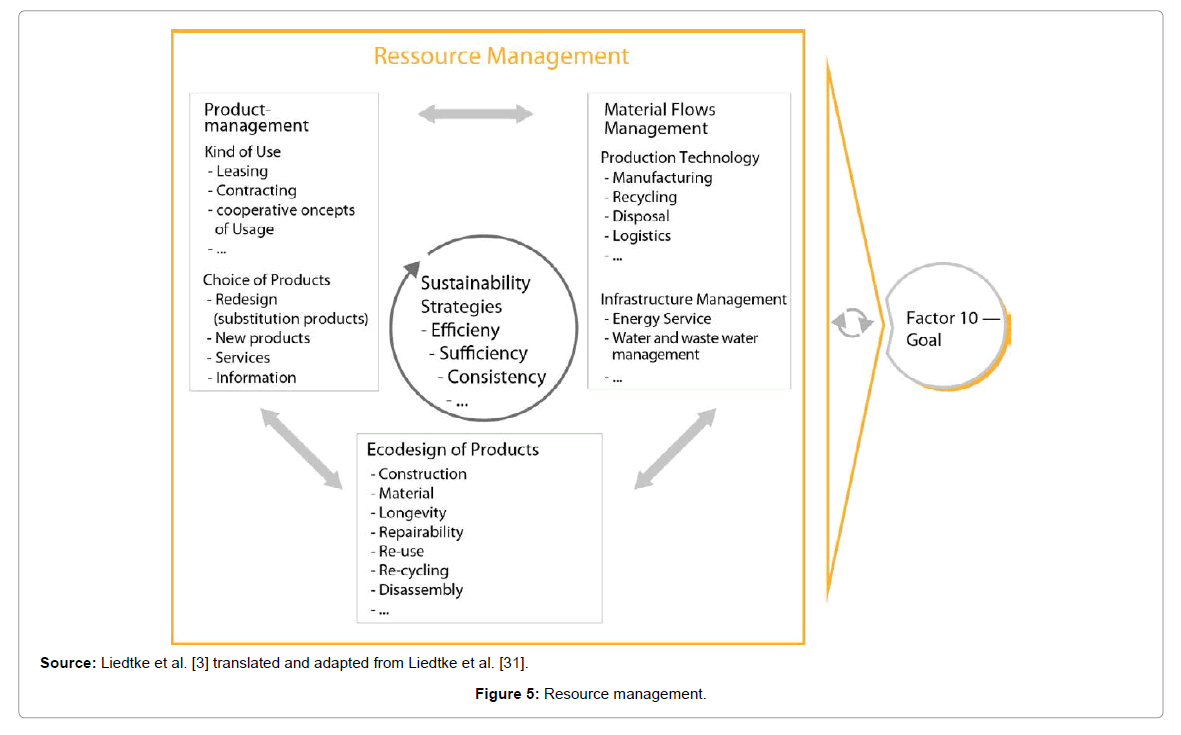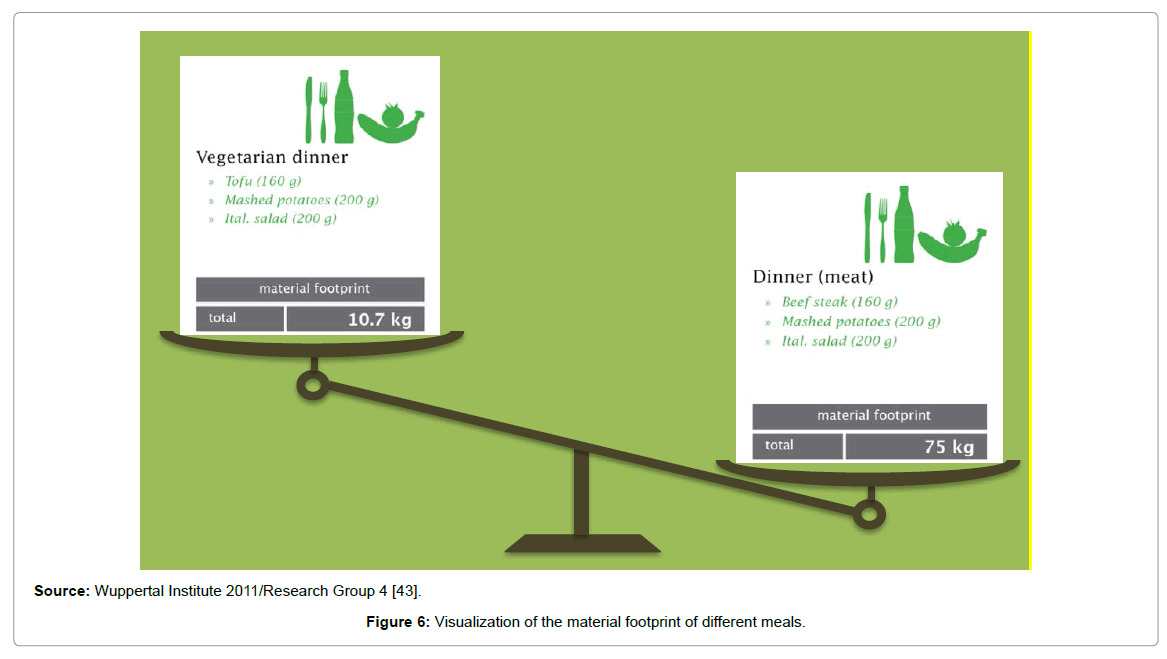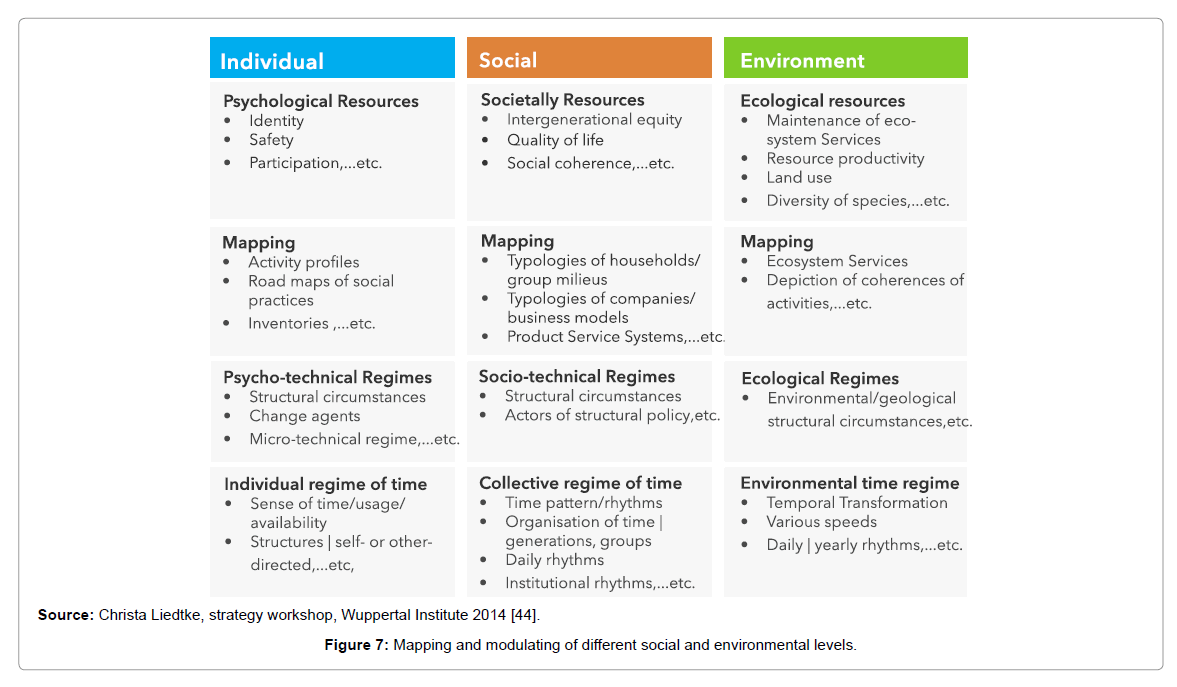Transformation Towards a Sustainable Society Key Intervention Areas
Received: 17-Jun-2015 / Accepted Date: 07-Jul-2015 / Published Date: 09-Jul-2015 DOI: 10.4172/2090-5009.1000117
Abstract
Social innovations, which transform resource intensive routines and practices into low-resource ones, combined with socio-technically designed transition paths, which are created around sustainability and environmental criteria, are milestones for implementation and diffusion of SCP (Sustainable Consumption and Production). This paper analyses such processes based on eight key components in order to evaluate and explain transformation and transition towards a sustainable lifestyle. Actors on all levels of society are included in this approach, creating a whole framework. Global megatrends, such as climate change, demographic change or resource scarcity will be put into relation with current policies and production trends, which play an important role for the development of transition pathways and future scenarios. This will enable us to work out guidelines and ideas on how to create a more sustainable society specifically.
Keywords: Transformation; Key intervention area; Sustainable consumption and production
17726Introduction
Social innovations, which transform resource intensive routines and practices into low resource ones, combined with socio-technically designed transition paths, which are created around sustainability and environmental criteria, are milestones for implementation and diffusion of SCP (Sustainable Consumption and Production).
Those transition-strategies, defined by their complexity in a multilevel governance system, are materialised via low resource and sustainable Product-Service-Systems (PPS), as well as infrastructures – referring to all products, services and infrastructures surrounding us. These can support and promote (but currently also inhibit) the development of more sustainable lifestyles and business models through their design [1].
Efficiency, consistency and sufficiency-strategies are taken as basis for sustainable design of PSS and its needed infrastructures, in order to inhibit negative rebound effects [2-4]2. If anything, sustainable design is able to produce positive rebound effects3 through materialised social innovations in the broad field of PSS (e.g. integrated Car Sharing in businesses, enterprises and at home; within the group of commuters living less than 10 km away from work, who take the bicycle instead of the car; within enterprises of the textile- and chemical-leasing industry, compare also [5,6]. The variety and creativity to be found within options for solutions and innovations is used as incremental basis for a societal and economical sustainable development and change.
To Visualize The Dimension, Talked About
Given that 24,6 Mio. German commuters (up to 10 km) use the bicycle instead of their car to commute to work; a reduction of 5.658.000.000 litres in fuel savings within a period of six months would be the result. The connected financial savings amount to around 8 billion Euro. This equals an estimated material footprint of 9.205.255 t and a carbon footprint of 15.661.344 t CO2. Overall, this scenario is optimistic. 10 km are most likely further, than many cyclist are willing to ride.”4
By calculating with only 25% of the effected commuters, 3 months with 5 working days each year and less than 5 km, we still find relevant results, especially as we only focus on one of the many practices in everyday life.
This contribution will try to work out key areas or key interventions of a change management aiming towards a more sustainable society and economy (Figure 1). The German Resources Commission 2014 defined eight structuring and integrating key intervention areas which are going to be explored in detailed, illustrated by Figure 1.
The needed innovation system is characterized by high complexity – social, material or substance-connected, structural, technological, action-oriented, but also institutional. It reaches and covers all levels of multi-level governance systems [7-20] and shows a detailed and encompassing system differentiation, as well as complexity of the system requirements on each of the levels. When introducing a social transition, such as „Commuting traffic by bike then by car”, every commuting person is able to imagine, which complex transformations would be implied: Bicycle lanes, deceleration of motor traffic, guidance systems for bicycles, security equipment and traffic education, parking and repair management, incentive structures in order to change, change of status symbols, communication strategies and campaigns, and much more.
At the same time responsibilities for the needed management of such a sustainable development of PSS are neither transparent nor comprehensible for the participating actors.
Participating agents are a various kinds of law-government/governance and economical systems, independent from each other or completely non-transparent within their global, common value chain. This leads to opaque power, decision- and management structures, which materialise themselves again in infrastructures and PSS.
Figure 2 illustrates the steps of a value chain including its whole complexity, explaining the manifesting and materializing integration of cultural and technical perspectives in the respective productionconsumption system within it. A sustainable design needs to be concerned about and affect all levels of the value chain/networks, as well as the integration of the system’s socio-technological and cultural perspectives, in order to detect and use mutual potentials. This is posing complex challenges to the competencies of all involved actors; challenges which they are not used to confront (yet). All the more it is important to create exploration spaces to study actively, to shape changes in a resilient and sustainable way.
Until recently consumer and consumption have not been acknowledged as active part of the value chain, but positioned as pure users of given structures and product coding, not accountable as influencing structural actor. As more and more sustainable developments, e.g. in the field of climate change, struggled to efficiently reach out into the public sphere, changes in how consumers are perceived occur. This is not surprizing given the fact, that the excluded system-actors are the target group for economy and PSS (Figure 2).
Designing A Low Resource Society
Technical advance does not necessarily lead to an advance in competition, because technologies and individuals need to fit together, before a new product works. Sustainability can play a relevant role on new markets, but needs to be explored. Green business plans, aiming towards maintenance of well-being and wealth, while lowering resource consumption and exploitation, try to maintain the same or even better possibilities for next generations. This can only be achieved by joint strategies. Liedtke et al. [3,4] described that possible scenarios of such lifestyles and societies can follow different low resource, but also intensive strategies, through following either a constructive or posing orientation and connected to societal frames and interpretations (Figure 3). Arguing further towards this position, a society of continuation tries to use efficiency strategies in order to resourcefully overcome borders. It has a sense or common knowledge of limits, but wishes to overcome them, by hoping for technical innovations, which would enable the actors to follow the already taken path of acceleration. Time and resource consumption, as well as interpretation of activity patterns are jointly related.
The latter is taken as even more important in the scenario of a “flow/passage-society”, inheriting a strong logic of enhancement and leading to a maintenance of old ways of doing, by using paths, which have brought wealth to industrial countries (Figure 3). This path would, according to all research results, lead to a doubling of resource extraction until 2030 [21,22].
The Steady Stock Society (for a resource related depiction of different scenarios comapre Bringezu and Bleischwitz [21], (Figure 3) instead inherits logic of limits and of squealing (Figure 3). Studying is connected a priori to socio-technical innovation logics – primary de-acceleration tendencies of action patterns are tested. Instead, the “society of creation” implements these logics more fundamentally – it already inherits expectations of arriving [23,24] and leads dialogues around this design. As for now the current generation in charge of decisions has only used a linear sense of time – the younger generation is present-oriented and adaptive [25]. In first instance this seems less constructive and future oriented, though it perforates the linearity of the pure goal orientation through the immanent present oriented sense of time (ibid.). To use both competencies and abilities to design a sustainable future oriented society will be the challenge for next years and decades.
A change of interpretation and then action patterns within complex societies is a multi-level governance approach; it can only be reached by simultaneous initiation on various levels and actor groups. These processes need time in order to be developed and tested, such as the intelligent resiliency management does. Incremental innovations can show long-range effects; sustainable means in this case also to be developed continuously for coming generations.
Environmental Space And Target Orientation
Biodiversity, land/soil protection, soil, air and water quality are seen as foundation of our ecosystems, which again are particularly important for our economy and well-being. Quantity of land is obviously limited, but should stay usable for the next generation. Biodiversity is highly relevant for eco-systemic stabilities, such as resiliency, and is therefore a key player for societal development and maintenance. Limited resources hence need to be used in a way, that allows regarding limits of nature [26-28].
“Sustainability (or Future-ability) has three core dimensions: One economical, one social and one ecological. The ecological dimension sets guardrails for economic and social development, because of the limited availability of natural resources and because the vital capacities of the eco-sphere, which can be reduced or destroyed by human actions, but not restored”. (Own translation of: Schmidt-Bleek [29].
In order to secure the eco-sphere, resource input, necessary for the functioning of PSS and co-siding infrastructures, has to be lowered.
So far the need for more natural resources is constantly growing – in 2030 a redoubling is expected (Bringezu et al. [21]. Lettenmeier et al. [26] describes necessary changes for households (resource consumption per person per year), as well as the fields of demand in finish households. Starting with a material footprint of 40 t per person per year and aiming at 8t until 2015, a reduction-factor of 5 is needed. How each person designs and create her or his own living space remains an individual decision. In order to stay within a sustainable management of the living and environmental space, a resource consumption of a maximum of 8 tons per person per year is necessary [26]. In order to understand the dimensions for the sociotechnical changes, (Table 1) is used as an example. The creation of one’s environmental space and the co-creation of PSS is an individual matter. (Table 1) depicts single activity fields for individuals. Living space decreases to an average of 20 m2 and the use of electricity, as well as heating is reduced by a factor of 6.8. In total Lettenmeier et al [26] proposes a reduction of the material footprint for housing from 10.8 to 1.6 tons per person per year.
| Housing from 10.8 to 1.6 tons/(person’s) | ||||
|---|---|---|---|---|
| Reduction required by | Factor 6.8 | Direct Consumption amount | Present | 38 m2/capital (house) |
| 11500 kWh (heat and electricity) | ||||
| Future | 20 m2/capital (zero energy house) | |||
| 1000 kWh (electricity) | ||||
| Share in household's material footprints | Present 27% | Material intensity | Present | 65 kg2/a (house, unheated/uncooled) |
| 0.6 k/kWh (Finnish heat and electricity) | ||||
| Future 20% | Future | 65 kg/m2/a (house, heated/cooled) | ||
| 0.3 kg/kWh (European electricity) | ||||
| Core statement | The material footprint for housing can be reduced from 10.8 to 1.6 tons/(person.a): -By developing zero-energy houses not exceeding present houses material intensity (i.e., strongly combining energy and resource efficiency); -By drastically shifting electricity production from fossils to renewables, especially wind and solar energy; and -By decreasing individual living space. The impacts of the latter on the individual wellbeing can be reduced by increasing shared living space and improving public space more liveable and attractive. |
|||
Table 1: Sustainable material footprint proposal for housing.
Development of e.g. zero-energy houses can only be achieved by an autonomous decision of the individual to engage in the thought of resource reduction and consumption. This is necessary for the resiliency of the system. Only technical or only social innovations are not sufficient to start a change in the system, while maintaining the same or similar strandards of living and the quality of life. Innovative socio-technical strategies for solutions and testing are needed, which help to achieve incrementalism towards intelligent PSS.
This means, that e.g. our mobility system must change fundamentally. Engine technology, traffic systems and consumer behaviour will lead to a radical increase in resource efficiency. The Schmidt-Bleek [29] works with clear limitations considering resource consumption and requires a co-existence of economy and eco-sphere, as well as an integration of all action and management strategies in the multi-level system, especially in the field of production.
Structural Framework And Change Actors
Action patterns and routines in the field of consumption and production need to be explored and implemented to achieve a societal transformation towards sustainability.
PSS are drivers of and also driven by societal and economical development. They build the ‘infrastructure’ or basis (PSS themselves) of resource consumption and work together with the systemic and surrounding infrastructure (e.g. mobility, logistics, communication), resulting in a mutual enhancement of energy- and resource consumption. Structures create structures and become embedded in everyday practices. A change can only start in the system itself. Social innovation can help a resilient transformation, by e.g. changing products to become more userfriendly and needs oriented. Solutions, instead of products need to be sold.
Figure 4 displays the actor as central for any action (for the following description compare Liedtke et al. [3,4] Welfens et al. [30]. Surrounding him, we find the PSS. These again are sided by markets, which are involved in sales, quality and infrastructure, and by political and cultural frames – all of which can be designed by actors and manifested in structures. Innovations, such as e-cars or passive-houses influence the consumption behaviour and the political framework, but also used technologies. These sides are intertwined, influencing each other mutually. Political frameworks include education, financial benefits and more, while cultural frameworks include values, identity and lifestyles, which are differentiated and have an impact on the choice of product. These levels are part of the meta-level, in which demography, globalization and climate change are placed.
Besides the individual consumer, ‘drivers’ on organisational level can steer production and consumption in different directions (Figure 4). This actor-centred view introduces change agents, individuals and institutions with greater capacities to initiate sustainable transformations, into the field of production and consumption. Every individual has potential to change – businesses actively decide in which cases to support greener solutions, the consumer decides whether to buy regional and seasonal product or not. Besides that, external drivers, such as costs and policies such as costs and policies for internal und external driving forces and improt and export, are playing a further key factor for transformation. Open explorative scenarios [15] support an exchange of knowledge between businesses, to reduce market failures of products. These are positive drivers, and as drivers are mostly created by humans and can usually be changed, a transfer from negative to positive driving forces is possible.
Process And Product Orientation
The actor-implemented change of the system can be accomplished by remodelling single processes and chains of production, and further by reshaping whole value chain systems. Step-by-step optimization including the whole cycle from the grave - life cycle wide is generated. The circle includes extraction, processing, using the product and its recycling or waste management. A whole resource management system is approached, which generates low resource PSS, supporting sustainable lifestyles (Figure 5).
The resource management integrates three areas (Figure 5) [31].
• Material flow management, which optimizes used raw materials, infrastructures and their inputs – this concerns each process, circuitry in production, transports, energy systems, production places and locations.
• Product design, the choice of material and all aspects of design, such as, longevity, recycling capacities and modular construction.
• Product management, which concerns every step from the kind of usage to the development of business models – their reconstruction, new design and redesign.
Sustainability strategies are incorporated in each management area of value added systems, including efficiency, sufficiency and consistency strategies, in order to develop resilient PSS. Theses strategies target production and consumption on the same level [17,27].
Exploration And Transition Orientation
Undirected changes, which “just appear”, like globalisation and changes through new technologies, only create reactive practices, as one simply adapts to the situation. The individual feels incapable of actively participating and take themselves out of the system, back to their subsystems – family, friends, job, back into areas where they can overview and control the situation. The strategy also reduces time put in the system, which is perceived as not to change anyway. In order to achieve a substantial change, this practice is fatal, as transition needs to be pushed by actors themselves.
Besides the Stockholm Resilience Centre [32] and other research institutions, dialogues on political level, such as the Expert Dialogue with the German Federal Chancellor (2012), start to discuss adaptive governance strategies and how to connect them to current scientific research, needed in social and economic spheres. Further projects and labels for quality, e.g. the Social Design Award (this year connected to projects which work with irregular migrants, https://www.hanssauerstiftung.de), link sustainability also to other current discourses. This transdisciplinarity includes a polycentric and multilevel approach of transformation, which possesses great capacities to link various actor together, especially through participation and collaborations.
Geels [33] argues, that deep social structures need to be transformed to lead to socio-technical transitions. This can include the turn to sustainable energy or a turn in mobility structures. A collective value needs to be formed, such as a common sense of low resource mobility and how to implement it.
Orientation Of Competence
Today there is a vast individual freedom and never were there more opportunities for education and individual or social well-being. Human capacities to overcome spontaneous everyday-life struggles are well known, may it be when there is another strike of public transportation, or on the airport, we can find complex changes and can manage them sufficiently and efficiently. Design competencies are multiple, resulting in the challenges to enable others and one to overcome environmental challenges over the next years and decades. Interpretations of ones incapability and surrendering to top-down implementations ignore the system-efficacy of the self on micro-level. Capability needs to be experienced, also through psychological processes (competence, relatedness, security, identity, distinction/popularity, stimulation [34,35].
Innovation structures for PSS like Living, especially Sustainabiltiy Labs [11,12,16,36] (https://suslab.eu) and further innovative projects can be used to support the mentioned competencies, which can be found on personal (the self), social and professional level. They work with trustworthiness and a certain toleration for failures, connected to cognitive abilities and mediation, organising and coaching skills. A social will for cooperation and engagement should exist besides professional qualifications, to lead complex change processes. When participating in the above mentioned projects, which underline the relevance of the consumer as a driving force in the system, active research is combined with direct implementation and testing of innovative products, which might affect everyday consumption and living [36,37].
Resource Culture – Design of a Low Resource Society
“Culture, understood as source and hotbed of immaterial resources is hence a necessary requirement for innovations in field of resource efficiency in enterprises” [38].
The social practices materialise themselves in the change of structures, which are e.g. connected to Car Sharing Systems or funded programmes for research and development in product design. The design can e.g. [39,40] deliver new charming ways to change decision and behaviour.
(Figure 6) displays the “weight” of a normal meal, one vegetarian, and one with beef. Some design innovations already try to include the information of e.g. a material footprint into new forms of production. One idea could be to display this information in a cafeteria of universities, in order to catch attention – trying to trigger a thought or at least an informed decision, what to eat. New and transformed action patterns and routines develop through those mechanisms and lead to cultures in which behaviour is aiming for need satisfaction in a room of limited environment. This specific resource culture becomes fundament of a future-oriented transition management, which includes people instead of excluding them through technology. An integrative sustainability management can only be created through this transformation. It has to be positive, creative and enable competence development. Starting points are informal rooms for exploration and formal education systems [11-16,41].
Design Of Tomorrow
Complex systems do not necessarily have to be non-transparent or incapacitating, but can be inspiring and exciting. Nevertheless we can find various time regimes, which are not easy to combine, an issue which has been neglected too often.
Geological and evolutionary biological time regimes are completely underlying different grades of development speed than human’s or societal. This is particularly interesting for a future-oriented research culture – the eco-systemic time regime will outlive time frames of human kind. Rhythm and speed in societies, but also rituals and mutual time, are reasons for the system’s stability and development. If it is too fast or inconsistent, a coherent and resilient development will fail, as all subsystems will loose their contact. The society gets unstable, if time and interpretation patterns are not based on common grounds – conflicts and the disconnection of necessary transition processes arise besides greater burdening the environmental area. Change can also be exhausting, because inventions have to be discussed including all steps that need to be accounted for (Figure 7).
Global megatrends, such as climate change, demographic change or resource scarcity play an important role for the development of transition pathways and future scenarios. The “8-ton (per capita and year-)society” [26] as future goal has been debated on social, economic and ecological levels, resulting in strategies, including multi-level plans, which integrate socio-technological and socio-economic systems, connecting them to each actor group.
Overall reflections on the eight key intervention areas can be concluded in a more specific guidance for further management tasks throughout the entire multilevel governance perspective in order to empower, enable and frame the potential of ‘sustainability change actors’ [42].
Future orientation
• Develop local, regional, national, European and international qualitative and quantitative scenarios for futures on all levels of the governance system
• Adapted deduction of priority measures, connected actions and lighthouse projects, as well as an introduction of interactive governance structures, including fitting structures of communication (strategies)
Ecosystem services
• Comprehensibly integrated and overarching mapping of ecosystemic services, as well as their description and their interactions (input orientation) (see also Resource Commission 2014)
• Description of cross points with socio-technical systems and material flows, like material management and timely capabilities of regeneration and issues around eco-systemic functions
Goal and result orientation
• Reflection of European and national discussions around solutions in areas of sustainable lifestyles and resource efficiency strategies
• Orientation towards indicators of input and their interfaces for a precautious management and system and future-oriented evaluation in a multi-level-system along the development of scenarios (see item 1) and development of data collection
Focus on structures and actors
• Starting dialogue with social and technical change agents in economic areas and value chains
• Integration of system actors as experts on their system in research and development, but also in implementation and diffusion
Process and product orientation
• Orientation on PSS as core of a change towards sustainability and climate change
• Mapping of representative social practices, which inherit potentials of transformation (positive rebound effects), as well as surrounding PSS – Mapping of technical and social innovation potentials for sustainability
Exploration and transition orientation
• Design and development of a research and development LivingLab infrastructure on local, regional, national, European and international level as‚ Nuclei’ of transition-management-processes
• Exploration of climate change efficient and low resource potentials of a society aiming towards resource conservation
Orientation of competence
• Development of learning and explorations fields, competency development (see LivingLab infrastructure - www.suslab.eu)
• Development and testing of sustainable PSS in LivingLabs connected and integrated into quarters of cities – Implementation and development of competency in everyday life, transformation of life and economy
Resource culture
• Mutual development of cultural identities towards sustainability and resource conservation
• Development of an interactive culture of communication to support a mutual resource culture – active use of social media for development of niche activities in order to learn new cultures of identity.
The above described and designed system management needs transparent and open information and management structures, which are able to adapt flexibly to actors’ needs. Structures of governance and government can support such innovative forms of sustainablility management actively. Further expolrations and real-life laboratories (see LivingLabs) on all actor levels are a necessity for further strengthening of societal tranformations.
References
- Schneidewind U (2015)Verantwortung für die Gesellschaft, Wissenschaft in der großen Transformation, in: PolitischeÖkologie 140: Forschungswende, Wissen schaffen für die Große Transformation, oekome.V. – Verein.
- Liedtke C, Buhl, J, Ameli, N (2013b) “Designing value through less by integrating sustainability strategies into lifestylesâ€, International Journal Sustainable Design2: 167-180.
- Liedtke C, Baedeker C, Borrelli LM (2015a) “StellschraubenfürNachhaltigkeit-Trends und Verantwortungen in Konsum and Produktionâ€, in: Globale Trends. Perspetkivenfür die Weltgesellschaft Fischer.
- Liedtke C, Baedeker C, Borrelli LM (2015b) “A Road Map for Sustainable Production and Consumption: Trends and Responsibilitiesâ€, in: Global Trends 2015. Prospects for World Society Fischer 283-297.
- Baedeker C, Greiff K, Grinewitschus V, Hasselkuß M, Keyson D et al. (2014) “Transition through sustainable Product and Service Innovations in Sustainable Living Labs: application of user-centred research methodology within four Living Labs in Northern Europeâ€, Paper for presentation at the 5th International Sustainable Transitions (IST) Conference August 27-29
- Leismann K, Schmitt M, Rohn H, Baedeker C (2012)Nutzen statt Besitzen : auf dem Weg zue iner ressourcenschonenden Konsumkultur ; eine Kurzstudie. Berlin : Heinrich-Böll-Stiftung (Schriften zur Ökologie ; 27)
- Geels FW (2004) “From sectoral systems of innovation to socio-technical systems: Insights about dynamics and change from sociology and institutional theory", Research policyNo 33: 897-920.
- Geels FW (2010) “Ontologies, socio-technical transitions (to sustainability), and the multi-level perspectiveâ€, Research Policy No 39: 495-510.
- Geels FW, Schot JW (2007) “Typology of sociotechnical transition pathways“, Research Policy36: 399-417.
- Verbong G, Geels F (2010) “Exploring sustainability transitions in the electricity sector with socio-technical pathways“, Technological Forecasting and Social Change77: 1214–1221.
- Liedtke C, Welfens MJ, Rohn H, Nordmann J (2012a) “LIVING LAB: user-driven innovation for sustainability“, International Journal of Sustainability in Higher Education No 13: 106-118.
- Liedtke C, Geibler JV, Baedeker C, Hasselkuß M, Jordan ND, et al. (2012b) “The sustainability living lab’ as a reflexive user-integratign research infrastructur“, in Proceedings of the 3rd International Conference on Sustainablility Transitions29-31.
- Liedtke C, Baedeker C, Geibler J, Hasselkuß M (2012c) “User-integrated innovation: sustainable LivingLabs research and development of sustainable products and services through user-driven innovation“, in: V. Fricke (ed.): Beyond consumption: pathways to responsible living, Berlin: TechnUniv203-218.
- Liedtke C, Baedeker C, Rohn H, Hasselkuß M, Grinewitschus V (2012d) Sustainable LivingLabs - European research infrastructure for the user-integrated development of sustainable product and service innovation (SusLabNWE)“, in: 17th International Sustainable Innovation Conference, 29th-30th October 2012, Alanus University Bonn.
- Liedtke C, Baedeker C, von Geibler J, Hasselkuß M (2012e)“User-integrated Innovation: Sustainable LivingLabs Research and development of sustainable products and services through user-driven innovation“, paper presented at the Conference Proceedings, 2nd PERL International Conference, “Beyond Consumption - Pathways to Responsible Livingâ€, 19-20 March 2012, Technische Universität Berlin.
- Liedtke C, Welfens MJ, Rohn H, Nordmann J (2012f) “Living Lab: UserÂDriven Innovation for Sustainabilityâ€, Int J Sustain High Edu No 13: 106-118.
- Liedtke C, Hasselkuß M, Welfens MJ, Nordmann J, Baedeker C (2013a) “Transformation towards sustainable consumption: Changing consumption patterns through meaning in social practices“, paper presented at the 4th International Conference on Sustainability Transitions, Contribution No 290 Zurich.
- Liedtke C, Buhl J, Ameli N(2013c) “Microfoundations for Sustainable Growth with Eco-Intelligent Product Service-Arrangements“, Journal Sustainability No5: 1141-1160.
- Liedtke C, Geibler JV, Baedeker C, Hasselkuß M, Jordan ND, et al. (2013d) “Living labs as a reflexive user-driven research infrastructure to promote sustainable consumption and production patterns: Experiences from exploratory research.“Paper presented at the 18th Annual International Sustainable Development Research Conference, 24-26
- Liedtke C, Hasselkuß M, Welfens MJ, Nordmann J, Baedeker C (2013e) “Transformation towards sustainable consumption: changing consumption patterns through meaning in social practicesâ€, in: 4th International Conference on Sustainability Transitions: IST; ETH Zurich Switzerland pp 702-729.
- Bringezu S, Bleischwitz R (2009) Sustainable resource management: global trends, visions and policies. Sheffield UK: Greenleaf.
- Bringezu S (2011) “Key elements for economy-wide sustainable resource managementâ€,Annales des Mines, SerieResponsabilité&Environnement No 1: 78-87.
- Schulze G (2003) Die besteallerWelten - Wohinbewegtsich die Gesellschaftim 21. Jahrhundert?Carl Handel Verlag: Munich.
- Schulze G (2009) “DasSteigerungsspiel. Auszügeaus “Die besteallerWeltenâ€,Wissenschaft&Umwelt, Interdisziplinär No. 13: 166-176.
- Schipperges M (2014) Strategy Workshop, Research Group 4, Wuppertal Institute, Sociodimensions, Institute for Socio-cultural Research.
- Lettenmeier M, Liedtke C, Rohn H (2014) “Eight tons of material footprint: suggestion for a resource cap for household consumption in Finland“, Resources No3: 488-515.
- Schmidt-Bleek F (1994) Wieviel Umwelt braucht der Mensch? MIPS, das Maßfu?r ökologisches Wirtschaften, Birkhäuser: Berlin, Basel, Boston.
- Spangenberg JH (1995) “Ein zukunftsfähiges Europa—Towards Sustainable Europe. Zusammenfassung einer Studie aus dem Wuppertal Institut.†Wuppertal Paper No 42: 1–66.
- Schmidt-Bleek F (2007)Â Nutzenwir die Erderichtig? Fischer-Taschenbuch-Verlag: Frankfurt am Main.
- Welfens MJ, Liedtke CJ, Nordmann (2010) Sustainable consumption: Between unsustainable reality and people's willingness to act. Knowledge collaboration & learning for sustainable innovation: ERSCP-EMSU Conference Delft The Netherlands 25–29.
- Liedtke C, Manstein C, Bellendorf H, Kranendonk S (1994) “O?ko-Audit und Ressourcenmanagement. ErsteSchritteeines EU-weitharmonisierungsfa?higenUmweltmanagementsystemsâ€, Wuppertal Paper 18 Wuppertal.
- Rockström J, Steffen W, Noone K, Persson Å, Chapin III FS, et al. (2009)A safe operating space for humanity, in: Nature 461: 472-475.
- GeelsFW (2011) “The multi-level perspective on sustainability transitions: Responses to seven criticisms“, Environmental Innovation and Societal Transitions 1: 24-40.
- Hassenzahl M, Diefenbacher S (2012) DIS 2012: Workshop Designing Wellbeing, 11-12 June, Newcastle, UK.
- Sen A (1993) Capability and Well-Being. The Quality of Life; Sen, Nussbaum, eds. Clarendon Press: Oxford UK pp 30–53.
- Liedtke C, Baedeker C, Hasselkuß M, Rohn H, Grinewitschus V (2014) User-integrated innovation in Sustainable LivingLabs: an experimental intrastruture for researching and developing sustainable product service systems. In press in: Journal of Cleaner Production 1-11
- Bliesner A, Liedtke C, Welfens MJ, Baedeker C, Hasselkuß M, et al. (2014) “Norm-Oriented Interpretation Learning†and Resource Use: The Concept of “Open-Didactic Exploration†as a Contribution to Raising Awareness of a Responsible Resource Use†Resources No 3: 1-30.
- Bliesner A, Liedtke C, Rohn H (2013) “Change Agents fürNachhaltigkeit: Was müssensiekönnen?â€,ZeitschriftFührung + Organisation No 1: 49-53.
- Hassenzahl M, Eckoldt K, Diefenbach S, Laschke M, Lenz E, et al. (2013) “Designing Moments of Meaning and Pleasure. Experience Design and Happinessâ€. International Journal of Design 7: 21–31.
- Hassenzahl M, Laschke M (2014) Pleasurable Troublemakers. In: S. Walz& S. Deterding (Eds.), TheGamefulWorld. Cambridge, MA: MIT Press 167-195.
- Baedeker C, Bahn-Walkowiak B, Bleischwitz R, Kolberg S, Mont O, et al. (2014) “Survey on consumption behaviour and its driving forces“, Final report, Wuppertal.
- Schneidewind U, Zahrnt (2014)The Politics of Sufficiency. Making it easier to live the good life, Oekom: München.
Citation: Liedtke C, Baedeker C, Borrelli LM (2015) Transformation towards a Sustainable Society – Key Intervention Area. Innov Energ Res 4: 117. DOI: 10.4172/2090-5009.1000117
Copyright: ©2015 Liedtke C, et al. This is an open-access article distributed under the terms of the Creative Commons Attribution License, which permits unrestricted use, distribution, and reproduction in any medium, provided the original author and source are credited.
Select your language of interest to view the total content in your interested language
Share This Article
Recommended Journals
Open Access Journals
Article Tools
Article Usage
- Total views: 16734
- [From(publication date): 8-2015 - Aug 18, 2025]
- Breakdown by view type
- HTML page views: 12079
- PDF downloads: 4655

